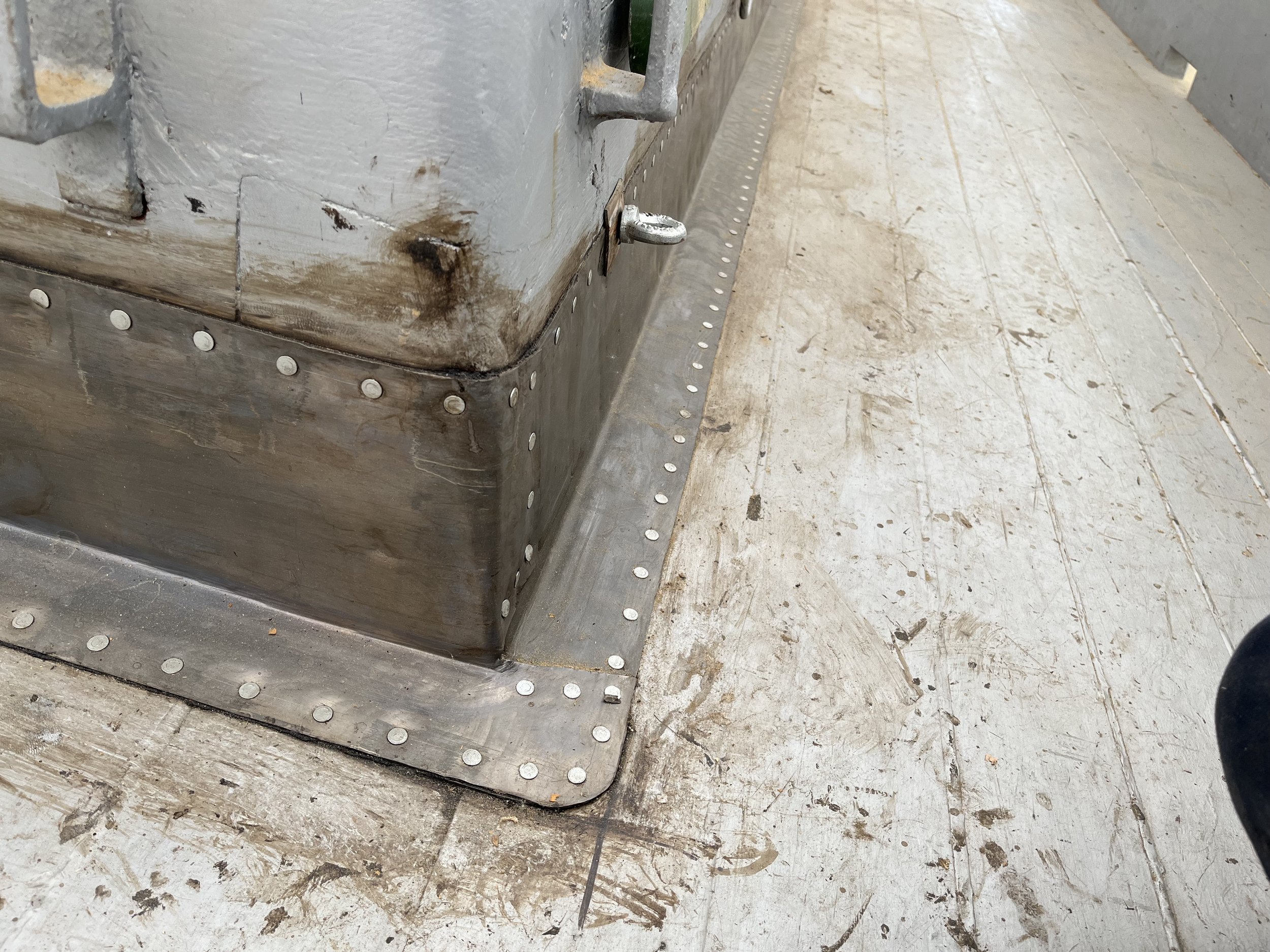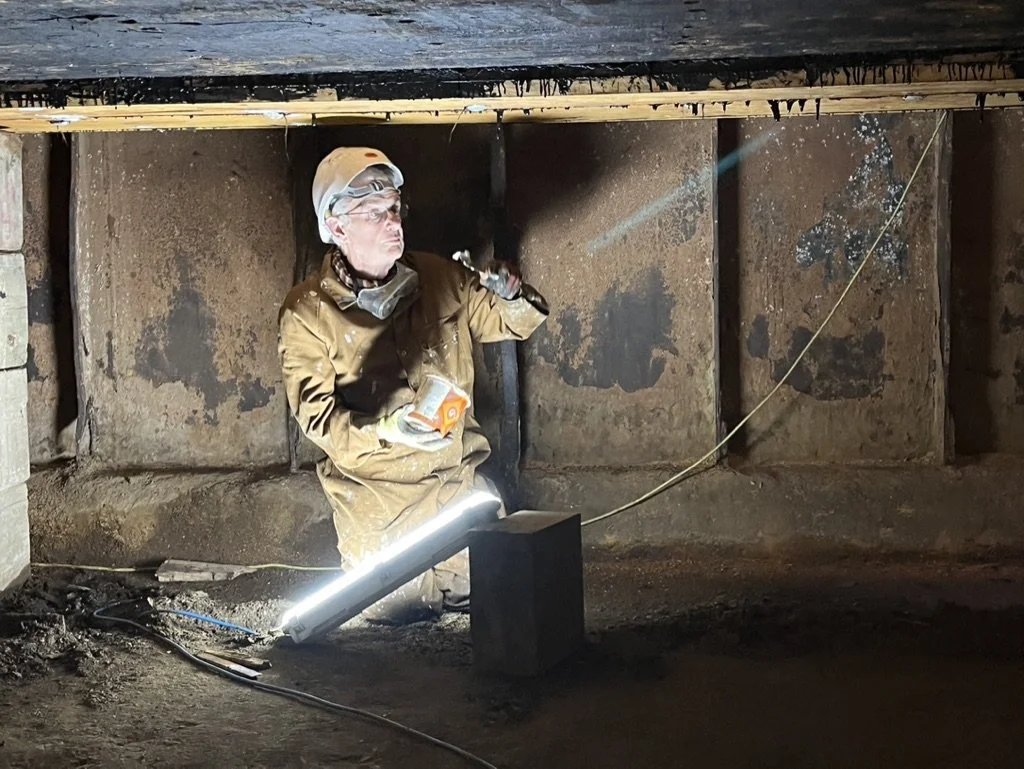Restoration Timeline
Hover over/click the drawing to discover how different sections of SB Raybel have been restored.
SB Raybel
Thames sailing barges were once common sights on the river and in London, with a fleet of around 2,000 in 1900. Today around 25 still exist in sailing condition. They were very distinctive, with red ochre sails. Being flat-bottomed they are perfectly suited to the shallow waters of the estuary, and are reckoned to be the largest sailing vessel to be handled by a crew of just two.
Raybel is 26m in length, with a beam (width) of 6.5m and draught (the maximum depth of the barge in water when fully loaded) of 2m. A typical barge carried 4,200 square feet (390 m2) of canvas in six working sails - main, top, fore, mizzen and (sometimes) a jib and jib topsail, both attached to the bowsprit.
See more about the SB Raybel restoration →Amidships
The amidships of a Thames barge is the cargo hold. This spacious area carried goods like grain, agricultural feed and timber, with cargo loaded through the hatches on deck. In her later life it became the venue space on Raybel, for music, theatre and dining.
See more about the Amidship restoration →Bow
The bow of a Thames sailing barge is a beautiful example of traditional design, with its upward curve, or sheer, which helped the barge ride smoothly through waves. Raybel's sheer is very pronounced, designed for the rougher waters of the North Sea as well as the tidal Thames.
See more about the Bow restoration →Deck
The deck of a Thames sailing barge is all about working the sails. The captain and crew would have expertly moved around the deck, adjusting sails and lines to harness the wind's power. Winches on each side controlled the raising and lowering of the distinctive leeboards, used to make progress when sailing against the wind.
See more about the Deck restoration →Stern
The stern of a Thames sailing barge would traditionally have been the skipper's cabin. On Raybel it was a fine space, with dining table and two bunks to the sides. From here the skipper could ascend to the deck, and take the wheel. Nowadays on Raybel the engine is housed in the stern. It's been that way since the late 1930s.
See more about the Stern restoration →Keep scrolling to view Raybel’s restoration timeline
June 2019
Funding approved by National Lottery Heritage Fund.
July 2019
Lloyd’s Wharf site handed over by Swale Council.
August 2019
Preparatory work starts in Milton Creek to make a safe berth.
September 2019
Raybel preparations start at Heybridge Basin in Essex for her Thames estuary crossing.
October 2019
Raybel crosses Thames estuary under her own power.
October 2019
Raybel arrives at Lloyd’s Wharf.
Raybel’s mast is raised to measure for new sails.
Volunteers are recruited to clear the ground around the museum.
Opening Day event day at the museum.
November 2019
December 2019
Reception for Swale councillors and relatives of the Wills family.
January 2020
The dry dock is raised from the bed of Stanhope Creek and towed to Lower Halstow Wharf for repairs.
February 2020
Volunteers, remove anchor chain and set up storage containers. Heavy mooring lines are donated.
New gates are fitted to the drydock.
The drydock and remains of Sailing Barge Westmoreland are visited as part of ‘National Historic Ships’ film about de-constructing vessels.
Eric the Pug makes first visit to Raybel.
June 2020
The drydock is cleared by the volunteer team.
The roof between the two storage containers is created to make a dry working space.
July 2020
First delivery of sail cargo to Lloyd’s Wharf for 50 years aboard the barge boat of Sailing Barge Dawn.
September 2020
Raybel’s gear is craned off. A deeper Wharf is prepared for the drydock insertion.
October 2020
The dry dock is flooded at the deepest part of the wharf.
November 2020
Raybel is pulled into the dry dock and firmly secured with blue ropes.
Her droopy bow section is jacked up inside the dry dock.
All her internal furniture and some bulkheads are stripped out.
January 2021
The cover is constructed over Raybel. Scaffolding is built around the outside and the rudder is lifted off with a telehandler.
February 2021
The new cover is fitted making a snug and dry tent for Raybel.
A delivery of crown head galvanised spikes arrives at a cost of £11,000.
The brutal process of removing the rails, quarter boards, covering boards, and deck planks starts.
March 2021
First delivery of English oak from a sawmill on the Sussex Kent border.
The front of the keelson is removed and the process of replacing the floor frames in the bows starts.
Handrails and chain stanchions are fitted on the wharf.
Frame doublers made of 8 inch square oak are fitted.
Rebuilding the steel carlings commences.
The first delivery of opepe wood arrives from Uganda via Grimsby.
April 2021
The mast case is removed for refurbishment.
The new wharf gates replace the temporary fencing.
The hull is stripped of paint to check its condition and find where the fixings are.
The new bow frames are reinforced with huge navel irons welded and bolted together.
May 2021
Volunteers start refurbishment of deck, fittings and hatches.
The original badge, removed in 1960, is retrieved from a shed in Maldon.
August 2021
New decking is machined on the wharf.
September 2021
Young work experience volunteers join the project.
The new apron piece is installed at the front of the boat.
Raybel is awarded a £500 bursary by the Transport Trust presented by Princess Ann.
November 2021
A new steel knee is fitted at the front, connecting the keelson with the new apron stem piece and the forward frame timbers.
Deck planking starts to go on. Each shaped piece is bolted and screwed down and the fixing hole filled with a wooden plug and epoxy resin.
January 2022
Outer wales are steamed into place and fixed with 3-foot-long steel “dumps”.
All internal paintwork is stripped. Inner wales are laminated from 3 layers of timber 1 inch thick.
February 2022
Decks are caulked and payed with hot tar.
A third delivery of opepe wood arrives. Raybel’s cover is destroyed by storm Darcy. New one fitted.
Covering boards—the thick wooden pieces that cover the edges of the deck are bedded down onto the frame tops.
A new windless head piece is fitted on the starboard side.
Rigging chocks are shaped and fitted.
March 2022
April 2022
New transom tops are fitted.
May 2022
Decks are painted with grey primer, rails are fitted. All fixing holes are filled with epoxy resin and wooden plugs. The quarter boards are fitted to the transom.
The tightly curved bow rails are steamed into place.
D-shaped, rubbing bands are made and fitted around the deck.
May 2022
The delicate name badge and scrolling is carved into the quarter boards by shipwright Tim Goldsack.
July 2022
All the new timber work is primed. Top sides completed and work starts on replanking the hull.
September 2022
The coamings are scraped. Fittings are removed from the old rudder to be reused on a new one.
November 2022
New steel rear lantern hatch fabricated by volunteers and fitted.
December 2022
8-month long process of removing the keel and chine bolts begins.
January 2023
Lead flashing fitted around coamings and windlass heads.
February 2023
Assistant shipwright Josh Goldsack starts fixing deck fittings such as cleats, fairleads.
March 2023
Internal lining of Douglas fir in bow is fitted.
May 2023
All new hull timbers are primed.
July 2023
Bow bottom planking is steamed into place.
Internal lining boards treated with pure linseed oil mixture.
August 2023
Timber arrives for new rudder assembly.
All women team of shipwright and two trainees were appointed.
Filming for a TV documentary.
September 2023
Chine doublers are fitted to the bottom of barge.
November 2023
Transom stern badge is re-carved ready for painting.
Glass deck prisms are resealed.
New companionway sliding hatch is constructed.
December 2023
Timber doubling of stern bottom begins.
New woodwork for the rear lantern hatch is made by volunteer craftsman.
Top coat colour scheme is applied all round.
New chocks for the main horse are roughed out of opepe wood.
January 2024
New keel and chine bolts are fitted. Chainplates are fitted. All bottom fixing holes are filled.
Name badges are coloured. Galvanised metal sheathing is fitted at bows to prevent damage from the anchor.
February 2024
Mast case is fitted. Delivery of timber for main horse – 0.7 tons of solid oak.
March 2024
Hull is painted with black tar varnish.
Main horse is fitted.
All underfloor bilge spaces are cleaned out ready for bilge water.
All gaps in hull are filled with softwood spills and epoxy resin, sanded, and painted.
Larger gaps are covered with temporary plywood patches until the timber plimms up (absorbs water). The forward knee cavity is filled with pitch.
Remaining Work 2024
Battery-powered bilge pumps installed. Scaffold walkway, cover and hoop frames are removed in preparation for refloat.
Raybel has creek water pumped in to swell dried out planks.
Raybel is refloated inside the dry dock.
The dry dock is sunk and after more than 3 years – Raybel is afloat and free once more.
Lee boards and rigging is all repainted.
Seizing’s treated with linseed oil paraffin mix.
All rigging, windlass, lee boards, brail winch, anchor, anchor chain, and rudder is lifted on by crane and the steering gear is reassembled
Mast is raised and all sail fits tested.
Sails are fitted and rigging adjusted.
The internal refit starts with 220 volt and 24 volt wiring, plumbing of two toilets, four sinks, shower and washing machine, heating, instruments.
Engine is serviced and new diesel fuel loaded.
New canvas covers are made for machinery and hatches.
The ship’s wheel is fitted.
The RBC bob (flag pennant) is mounted.


















































